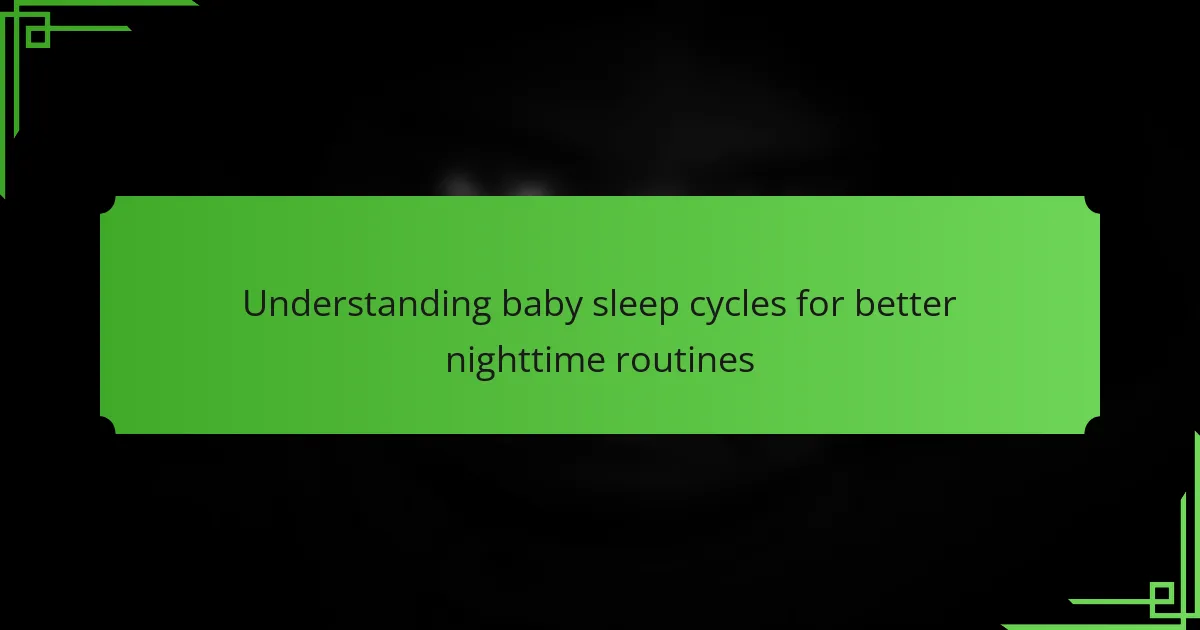Baby sleep cycles refer to the distinct patterns of sleep that infants experience, typically lasting 50 to 60 minutes and encompassing stages of light and deep sleep. Understanding these cycles is essential for parents seeking to improve their infants’ sleep quality and establish effective nighttime routines. Key indicators of a baby’s readiness for sleep include behaviors like eye rubbing, yawning, and fussiness, which signal the need for timely responses to enhance sleep patterns. Establishing a consistent sleep schedule and creating a calming pre-sleep environment are also vital for promoting better sleep in infants. Research supports the idea that recognizing sleep cues and implementing soothing rituals can significantly improve overall sleep quality for both babies and parents.

What are baby sleep cycles?
Baby sleep cycles are the patterns of sleep that infants experience throughout the night. These cycles typically last around 50 to 60 minutes in babies. Each cycle includes stages of light sleep and deep sleep. During light sleep, babies may move or make noises. In deep sleep, they are quieter and more restful. Babies spend more time in REM sleep compared to adults. This phase is crucial for brain development. Understanding these cycles can help parents establish better sleep routines for their infants. Research indicates that recognizing baby sleep patterns can improve nighttime sleep quality for both babies and parents.
How do baby sleep cycles differ from [censured] sleep cycles?
Baby sleep cycles differ significantly from [censured] sleep cycles. Babies typically have shorter sleep cycles, lasting about 50-60 minutes. In contrast, [censured] sleep cycles last approximately 90 minutes. Babies spend more time in REM sleep, which is crucial for brain development. Adults have a more balanced distribution of REM and non-REM sleep. Babies may wake frequently during the night due to shorter cycles. Adults generally experience longer periods of uninterrupted sleep. This difference in sleep architecture is essential for understanding infant sleep patterns and developing effective nighttime routines.
What are the stages of sleep in babies?
Babies experience two main stages of sleep: active sleep and quiet sleep. Active sleep is characterized by rapid eye movement (REM) and is when dreaming occurs. During this stage, babies may move, make noises, and even smile. Quiet sleep, on the other hand, is a deeper sleep without eye movement. In this stage, babies are less likely to wake up easily.
Newborns spend about 50% of their sleep in active sleep and 50% in quiet sleep. As they grow, the proportion of quiet sleep increases. By six months, babies typically spend more time in quiet sleep compared to active sleep. Understanding these stages helps caregivers create better nighttime routines for babies.
How long do baby sleep cycles typically last?
Baby sleep cycles typically last about 50 to 60 minutes. During this time, babies progress through different sleep stages. These stages include light sleep, deep sleep, and REM sleep. Each cycle is essential for their growth and development. Research indicates that newborns may sleep for longer durations, around 16 to 18 hours a day. As they grow, the duration of sleep cycles may lengthen. Understanding these cycles can help caregivers establish better nighttime routines.
Why is understanding baby sleep cycles important?
Understanding baby sleep cycles is important for optimizing their sleep quality. Babies experience different sleep stages, including REM and non-REM sleep. Each cycle lasts about 50-60 minutes. Knowledge of these cycles helps caregivers anticipate waking times. This can lead to better sleep routines. Improved routines can enhance overall well-being for both baby and parents. Research shows that consistent sleep patterns support cognitive development in infants. Understanding sleep cycles therefore aids in creating a nurturing sleep environment.
How can knowledge of sleep cycles improve nighttime routines?
Knowledge of sleep cycles can significantly enhance nighttime routines. Understanding sleep cycles allows caregivers to align bedtime activities with a baby’s natural rhythms. Babies experience different sleep stages, including REM and non-REM sleep. Each cycle lasts about 50-60 minutes. By recognizing these cycles, caregivers can minimize disturbances during transitions between sleep stages. This can lead to smoother bedtimes and fewer wake-ups. Research indicates that babies who follow their natural sleep patterns tend to sleep longer and more soundly. Improved nighttime routines can result in better overall sleep quality for both the baby and the caregivers.
What impact do sleep cycles have on a baby’s development?
Sleep cycles significantly impact a baby’s development. They influence cognitive growth, emotional regulation, and physical health. During sleep, babies experience rapid eye movement (REM) sleep, which is crucial for brain development. REM sleep aids in memory consolidation and learning. Additionally, consistent sleep cycles help regulate a baby’s circadian rhythm. This regulation supports better mood and behavior. Research indicates that infants who have structured sleep patterns show improved attention and problem-solving skills. Proper sleep also contributes to physical growth, as growth hormone is primarily released during sleep. Therefore, healthy sleep cycles are essential for overall development in babies.

How can parents recognize their baby’s sleep cues?
Parents can recognize their baby’s sleep cues by observing specific behaviors. Common signs include rubbing eyes, yawning, and fussiness. Babies may also become less active or lose interest in toys. These cues indicate that the baby is tired and ready for sleep. Research shows that responding to these signs can improve sleep quality. A study published in the Journal of Developmental & Behavioral Pediatrics found that timely responses to sleep cues lead to better sleep patterns in infants. Recognizing these cues helps parents establish a consistent sleep routine.
What signs indicate a baby is ready for sleep?
A baby is ready for sleep when they show signs of tiredness. Common indicators include yawning, rubbing their eyes, or becoming fussy. Additionally, a baby may lose interest in toys or activities. They might also have decreased physical activity and become more clingy. These signs often appear after the baby has been awake for a certain duration, typically around 1.5 to 2 hours for younger infants. Recognizing these cues can help parents establish a consistent sleep routine. Consistent sleep routines support better sleep quality for babies.
How can parents differentiate between tiredness and other states?
Parents can differentiate between tiredness and other states by observing specific behavioral cues. Tiredness often manifests as fussiness, yawning, or rubbing eyes. In contrast, other states like hunger may show signs of rooting or smacking lips. Additionally, discomfort from a wet diaper can lead to crying or squirming. Monitoring the timing of these behaviors is crucial. Tiredness typically occurs after a certain period of wakefulness, usually between 1.5 to 2 hours for infants. Recognizing these patterns helps parents respond appropriately to their child’s needs.
What common sleep cues should parents look for?
Common sleep cues parents should look for include rubbing eyes, yawning, and fussiness. These signs indicate that the baby is tired and ready for sleep. Other cues may include decreased activity and looking away from stimuli. Research shows that recognizing these cues can help establish a consistent sleep routine. Parents can improve sleep patterns by responding promptly to these signals. Ignoring sleep cues may lead to overtiredness, making it harder for the baby to fall asleep. Understanding these cues is essential for better nighttime routines.
How can parents create a conducive sleep environment?
Parents can create a conducive sleep environment by ensuring the room is dark, quiet, and cool. Darkness promotes melatonin production, which helps regulate sleep cycles. A quiet atmosphere minimizes disturbances that can interrupt sleep. The ideal room temperature for infants is between 68-72°F (20-22°C) for optimal comfort.
Additionally, using white noise machines can mask sudden sounds that may wake a baby. A consistent bedtime routine signals to the baby that it’s time to sleep. This can include activities like bathing, reading, or gentle rocking. Finally, a comfortable crib or mattress supports healthy sleep posture, contributing to better rest.
What factors contribute to a baby’s sleep environment?
A baby’s sleep environment is influenced by several key factors. These include room temperature, noise levels, lighting, and bedding. Optimal room temperature for infants is typically between 68 to 72 degrees Fahrenheit. Excessive noise can disrupt sleep, so a quiet environment is preferred. Dim lighting or complete darkness helps signal to the baby that it is time to sleep. Safe bedding, such as a firm mattress and fitted sheets, reduces the risk of suffocation. Additionally, the presence of a consistent sleep routine can further enhance the sleep environment. Studies show that these factors collectively contribute to better sleep quality for infants.
How does room temperature affect baby sleep quality?
Room temperature significantly affects baby sleep quality. An ideal room temperature for infants is between 68°F and 72°F (20°C to 22°C). Temperatures outside this range can lead to discomfort. If the room is too hot, babies may experience restlessness and difficulty falling asleep. Conversely, a room that is too cold can disrupt sleep and lead to waking. Research indicates that maintaining a comfortable temperature helps regulate a baby’s sleep cycles. A study published in the journal “Pediatrics” found that infants in optimal temperatures slept longer and had fewer awakenings. Thus, ensuring a suitable room temperature is crucial for improving baby sleep quality.

What strategies can enhance a baby’s sleep routine?
Establishing a consistent sleep schedule enhances a baby’s sleep routine. Babies thrive on routine. A regular bedtime helps signal to the baby that it is time to sleep. Creating a calming pre-sleep environment promotes relaxation. Dimming lights and reducing noise can aid in this process. Implementing a soothing bedtime ritual, like reading or bathing, can further prepare the baby for sleep. Limiting screen time before bed is also beneficial. Research indicates that consistent sleep patterns improve overall sleep quality in infants.
What are effective bedtime routines for babies?
Effective bedtime routines for babies include a consistent sequence of calming activities. These activities can involve a warm bath, gentle massage, or soft music. Reading a short story can also help signal bedtime. Dim lighting creates a soothing environment. Establishing a specific bedtime reinforces the routine. Babies thrive on predictability, which helps them feel secure. Research indicates that consistent bedtime routines improve sleep quality in infants. A study published in the journal “Pediatrics” found that babies with regular routines fell asleep faster and slept longer.
How can consistency in bedtime affect sleep cycles?
Consistency in bedtime stabilizes sleep cycles. When bedtime is regular, the body’s internal clock aligns with sleep patterns. This leads to improved sleep quality and duration. Research indicates that irregular sleep schedules can disrupt circadian rhythms. Disruption may cause difficulty falling asleep or waking up. Consistent bedtimes promote deeper sleep stages. Studies show that children with regular bedtimes exhibit better overall sleep. This results in enhanced mood and cognitive function during the day.
What activities should be included in a bedtime routine?
A bedtime routine should include calming activities that prepare a baby for sleep. Activities can involve dimming the lights to signal nighttime. Reading a short story can promote relaxation and bonding. Gentle rocking or swaying can soothe a baby and aid in falling asleep. A warm bath may help to relax muscles and signal the end of the day. Soft music or lullabies can create a peaceful atmosphere conducive to sleep. Lastly, consistent timing of these activities reinforces a sleep schedule. Research indicates that a structured bedtime routine improves sleep quality in infants.
How can parents address common sleep challenges?
Parents can address common sleep challenges by establishing a consistent bedtime routine. A routine helps signal to the baby that it is time to sleep. This can include activities such as bathing, reading, or singing lullabies. Research shows that a predictable routine can improve sleep quality in infants (Mindell et al., 2015, Journal of Clinical Sleep Medicine). Parents should also create a conducive sleep environment. This means ensuring the room is dark, quiet, and at a comfortable temperature. Limiting screen time before bed is essential, as blue light can interfere with sleep hormones. Additionally, parents can observe their baby’s sleep cues, such as rubbing eyes or fussiness, to identify when they are ready for sleep. Addressing feeding schedules can also help, as babies may wake due to hunger. By following these strategies, parents can effectively tackle common sleep challenges.
What are typical sleep disruptions in babies?
Typical sleep disruptions in babies include frequent awakenings, difficulty falling asleep, and changes in sleep patterns. Babies often wake up multiple times during the night. This can be due to hunger, discomfort, or developmental milestones. Sleep regressions can occur around 4 months, 8 months, and 18 months. These regressions may lead to increased night wakings. Additionally, teething can cause discomfort, disrupting sleep. Environmental factors like noise or temperature can also affect a baby’s sleep. Understanding these disruptions can help parents create better nighttime routines.
How can parents manage sleep regression phases?
Parents can manage sleep regression phases by maintaining a consistent bedtime routine. Establishing a calming pre-sleep environment helps signal to the baby that it’s time to sleep. Parents should also be patient and recognize that sleep regressions are temporary. During these phases, babies may wake more frequently or resist sleep. Offering comfort through gentle rocking or soothing sounds can help ease their distress. Keeping a consistent sleep schedule is crucial, as it reinforces the baby’s internal clock. Research indicates that predictable routines can improve sleep quality and duration. A study published in the Journal of Pediatric Psychology found that consistent bedtime practices significantly reduce sleep disruptions in infants.
What practical tips can help improve baby sleep cycles?
Establishing a consistent bedtime routine can significantly improve baby sleep cycles. This includes activities like bathing, reading, or singing before sleep. Keeping the sleep environment dark and quiet promotes better rest. A comfortable room temperature, ideally between 68-72°F, supports deeper sleep. Limiting screen time before bed helps reduce stimulation. Feeding the baby before sleep can prevent wakefulness due to hunger. Encouraging self-soothing techniques allows babies to fall back asleep independently. Research shows that these methods can lead to longer sleep durations and fewer night awakenings.
The main entity of this article is baby sleep cycles, which are the patterns of sleep that infants experience, typically lasting 50 to 60 minutes and consisting of stages such as light sleep, deep sleep, and REM sleep. The article explores how baby sleep cycles differ from [censured] sleep cycles, the stages of sleep in babies, and the importance of understanding these cycles for establishing effective nighttime routines. It also provides practical tips for parents on recognizing sleep cues, creating a conducive sleep environment, and addressing common sleep challenges, thereby enhancing overall sleep quality for both infants and caregivers.
